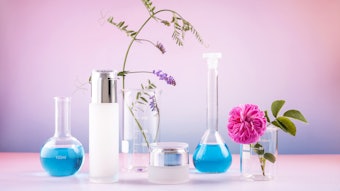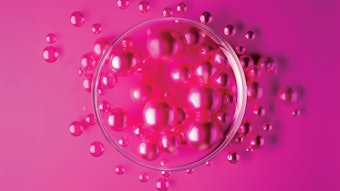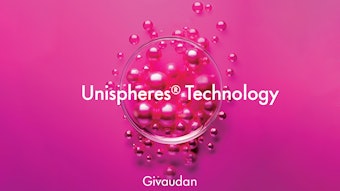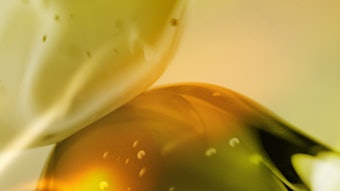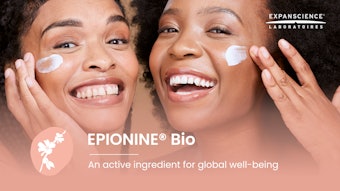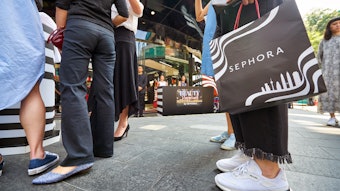Natural fragrance companies are often interested in the olfactory impact that plant extracts can have for the design of new facets of fragrances. The hydrodistillation of plants yields essential oils characterized by molecules with relatively high volatility that often are used for the top and middle notes—the two most volatile fractions—of a fragrance. Traditional aromatherapy has claimed that essential oils have activity on the skin but only recently has research substantiated that essential oils can act as actives in cosmetic products. For example, the most recognized use of essential oils has been for antimicrobial activity against Propionibacterium acnes1 or Malassezia furfur2 for acne and anti-dandruff applications. Moreover, studies have highlighted the use of essential oils as potential anti-inflammatory and antioxidant agents. 3, 4
Log in to view the full article
Natural fragrance companies are often interested in the olfactory impact that plant extracts can have for the design of new facets of fragrances. The hydrodistillation of plants yields essential oils characterized by molecules with relatively high volatility that often are used for the top and middle notes—the two most volatile fractions—of a fragrance. Traditional aromatherapy has claimed that essential oils have activity on the skin but only recently has research substantiated that essential oils can act as actives in cosmetic products. For example, the most recognized use of essential oils has been for antimicrobial activity against Propionibacterium acnes1 or Malassezia furfur2 for acne and anti-dandruff applications. Moreover, studies have highlighted the use of essential oils as potential anti-inflammatory and antioxidant agents. 3, 4
To measure the antioxidant ability of essential oils, experiments must be carefully designed, as demonstrated by the work of Zhao5 and by the author, described here,6 since the design obviously affects the outcome. For example, whereas some work has reported on the antioxidant activity of essential oils, work by the author has shown that only essential oils having a high quantity of phenolic molecules, such as eugenol and thymol, can act as efficiently as the well-established free radical scavengers BHT and vitamin E. Extraction from plants by volatile solvents yields an absolute that captures volatile notes as well as molecules with sustainable odor, which contribute to the heart and bottom note of a fragrance.
Quantitative analysis of most absolutes has identified heavier molecules such as flavons, diterpenes and triterpenoïds;7 esters and lactones;8 and polyols, acids, fatty acids and sterols9 that may have interesting cosmetic properties. One objective of the Robertet
Aromacosmetic Laboratory is to study the different properties of these extracts and use them as building blocks for the development of functional active fragrances. Recent research has expanded to evaluate the effects of such materials on skin lightening, soothing and slimming.
The aim of the present work was to investigate the complementary use of natural extracts in an active fragrance with broad-spectrum activity against well-recognized skin aging factors. Previous in vitro tests performed at the company on single natural extracts were used to help researchers create a fragrance containing 50% or more of the several active compounds identified. Results reported here were obtained for a single active fragrance with multiple antiaging activitiesa.
Skin Aging
To examine the activity of the tested extracts, one first must consider the mechanisms of skin aging. Skin aging is a complex phenomenon. The two most commonly recognized processes of aging are chronological, involving genetic factors; and photo-aging, involving environmental factors. It is generally accepted that these mechanisms impact the physiology of skin by changing the evolution of extracellular matrix (ECM) proteins in proportion and organization via a degradation process initiated by matrix metalloproteinase, hyaluronidase and elastase. This process may be the key factor in the development of wrinkles.10
In the case of photo-aging, exposure of skin to sunlight produces reactive oxygen species (ROS), free radicals and singlet oxygen. These damaging species have deleterious effects on constituents of the skin ranging from the sebum to the dermis, and are involved in the enzymatic cascade. To stop them, it is necessary not only to act against free radical species, but also singlet oxygen.
ROS: ROS species including singlet oxygen and free radicals react in different damaging ways on the skin. Free radicals promote the cycle of peroxidation via hydrogen abstraction, while singlet oxygen reacts following a Diels Alder or ene reaction11 to result in peroxide formation. Thus, ROS play a complementary role in the auto-
oxidation of lipids in the skin. To combat the damaging effects of both species of ROS, multiple approaches are needed because free radical scavengers such as BHT alone are ineffective against singlet oxygen.12
Singlet oxygen has been shown to promote the creation of squalene monohydroperoxide in sebum12 and appears to be involved in the early formation of the primary radical in unsaturated lipids.13 Consequently, squalene peroxide on guinea pig dorsal skin14 provokes erythema and histological changes such as acanthosis, hyperkeratosis and vacuole degeneration in the epidermis. Moreover, squalene peroxide appears to be a major factor in skin wrinkle formation,15 as well as a comedogenic agent.16
Studies on three-dimensional cultured human skin models suggests that squalene peroxide causes the peroxidation of cellular membrane lipids within the dermis and epidermis, and decreases the viability of keratinocytes and increasing interleukin-2 release.17
The role of free radicals in the formation of lipid hydroperoxide and in the depletion of natural antioxidants is well-documented.18 The production of free radicals by UV exposure can even lead to the modification of the lipid bilayer and DNA. Moreover, free radicals appear to activate the production of matrix metalloproteinases (MMPs) through the activation of the AP-1 transcription factor.19 Thus, preventing the start of the entire ROS process is a vital first step in defending against skin aging. The important second step would be to prevent the degradation of the ECM by the action of MMPs, elastase and hyaluronidase.
MMPs and serine proteinase: The family of MMPs is well-known for its role in degrading the ECM. This degradation is thought to be an influential factor in the initiation of skin wrinkles and skin sagging. The inhibition by the fragrance of two distinct metalloproteinases, namely MMP-3 and MMP-9, and the serine protease human leucocyte elastase (HLE), were studied in the present work since they are responsible for the degradation of different structural proteins.20
Human fibroblast stromelysin-1 or MMP-3 is a proteoglycanase with a wide range of substrate specificities. It is capable of degrading proteoglycan, fibronectin, laminin and type IV collagen.
The process of secreting such metalloproteases is predominantly governed by connective tissue cells. MMP-3, upregulated in fibroblasts after UVB exposure, is an important contributor to the photo-aging process.21 The secretion of MMP-9, also known as 92-kD gelatinase or type V collagenase, is stimulated by UVB irradiation in a dose-dependent manner; it is actually decreased by UVA.22 MMP-9 is also known to be an agent responsible for the photo-degradation of skin collagen fibers.20
In addition, serine protease was examined. Skin exposure to UV promotes the activity of the serine protease known as HLE.23, 24 This enzyme acts as a mimic of true collagenase because it is responsible for the degradation of ECM proteins such as elastin, fibronectin and collagen, resulting in the loss of skin elasticity and the apparition of wrinkles.
The inhibition of these enzymes would protect the main proteins of skin structure. Moreover, since the ECM content in glycosaminoglycans such as hyaluronan is an important part of the dermis structure, the inhibition of the hyaluronidase by the active fragrance also was studied.
Hyaluronan and hylauronidase: Hyaluronan is a high molecular weight polymer of repeating units of N-acetylglucosamine D-glucuronic acid that is synthesized in the plasma membrane of cells and translocated to the peri-cellular space. It is believed to have numerous important biologic functions, including modulation of cell proliferation, migration and differentiation, as well as the regulation of extracellular water and protein homeostasis. Produced by fibroblasts and keratinocytes, it is included in the ECM component of the skin.25
Several studies have revealed the presence of hyaluronan in the dermis and epidermis, and indicate that it can be transferred in the stratum corneum (SC).26 The degradation of this component is assumed to be linked with free radicals27 and hyaluronidase,28 which is regulated via UVB exposure but by a different pathway.25
Methods
To determine the antiaging benefits of the active fragrancea in question, the author compared it with two standard fragrances from the company’s library and tested them at the same concentration in various in vitro and ex vivo protocols, described below. The increased activity of the active fragrance was due to its design around ingredients identified in previous studies as exhibiting efficacy against the skin aging factors described above. The active fragrance contained at least 50% of the active compounds identified in the initial screening step. The control fragrances showed little or no activity on each of the protocols. Depending on the test, some ingredients of the active fragrance were removed since they caused interactions with the reagents such as discoloration, independently of the enzyme activity being studied, especially during the hyaluronidase testing. All testing was performed in triplicate.
MMP-3 and MMP-9: The ability of the active fragrance to inhibit the human MMP-3 and MMP-9 was evaluated by a colorimetric assay test method. The assay measures the degradation by the two enzymes of a chromogenic substrate (Ac-PLG-[2-mercapto-4-methyl-pentanoyl]-LG-OC2H5) (see Figures 1 and Figure 2).
Elastase: The effect of the active fragrance on leucocyte elastase activity was performed according to Mitaine-Offer.29 HLE activity was measured using N-methoxysuccinyl-Ala-Ala-Pro-Val-4-nitroanilide as a substrate. The release of the p-nitroanilide subsequent to hydrolysis of the substrate was monitored by a spectrophotometer at 405 nm. A 0.015% concentration of the active fragrance was compared with ursolic acid at 0.002% and found to decrease the activity of the elastase by nearly 50% (see Figure 3).
Hyaluronidase: The effect of the active fragrance on the activity of hyaluronidase was measured following a modified colorimetric assay based on the reaction of N-acetyl-D-glucosamine at the reducing ends of hyaluronan and its fragments with p-dimethyl aminobenzaldehyde. This modification results in a red-colored product that can be monitored via a spectrophotometer at
590 nm.30 The efficacy of the fragrance was compared with apigenin, and the active fragrance at 0.2% was found to decrease the activity of hyaluronidase by 80% (see Figure 4).
Anti-ROS Activity
Singlet oxygen: Singlet oxygen can be produced by photosensitization of Rose Bengal with an appropriate wavelength of light. This sensitizer is excited and transfers its energy to triplet oxygen. The probe 1,3 diphenyl isobenzofuran, which undergoes direct reaction with singlet oxygen, resulting in a loss of absorbance at 410 nm, can be monitored with a spectrophotometer.31 The quenching activity of the fragrance on singlet oxygen can be monitored by comparing the loss of absorbance of the placebo versus the fragrance tested. From these results the researcher concluded that the active fragrance could be an efficient quencher of singlet oxygen (see Figure 5).
Ex vivo DPPH test: An ex vivo DPPH test method was used to measure the efficacy of the active fragrance on improving the free radical scavenging ability of the SC. Application on both forearms of a classical o/w skin cream containing the active fragrance at 0.6% and a placebo, and an o/w cream with a standard fragrance at 0.6%, was conducted by seven volunteers. All were asked to use the same amount of cream as they typically would for body applications. After application and a
1.5-hr resting period, an extraction using ethanol on both forearms was made at three different sites and pooled together. These samples were filtered and 0.8 mL of each was added to a precise amount of a DPPH((diphenyl-2-picryl-hydrazyl:DPPH) solution at 50mg/L. DPPH is a stabilized free radical that is used to predict the antioxidant
activity of an extract; in this case, the ethanolic extract of the skin. The comparison is made with the placebo extract, which contains nonenzymatic antioxidant from the skin, extracted by ethanol, which is mainly vitamin E (α and γ tocopherol),32 considered in this test as the endogenous protection. The results obtained showed an increase of the free radical scavenging ability of the ethanolic extract of skin 1.5 hr after the application of the cream containing the active fragrance, compared with a standard fragrance (see Figure 6).
Conclusions
In the present study, a single active fragrancea was tested in vitro and found to exhibit efficacy against five primary factors of skin aging. In addition, an ex vivo test revealed its free radical scavenging ability. The active fragrance developed was designed with complementary ingredients that have olfactive and cosmetic benefits to provide a broad-spectrum activity. This active fragrance provided both the pleasure of scent as well as antiaging activity.
From a formulation point of view, the advantages are numerous since the incorporation of fragrance is typically a trivial step in the formulation process, contrary to the inclusion of usual actives. Fragrance could thus become a crucial point in the formulation of a cosmetic product. Indeed, it could be of interest to formulators to add a fragrance with anti-hyaluronidase activity to a moisturizing cream containing hyaluronan, or to boost the antioxidant portion of a daily cream containing superoxide dismutase. Fragrances containing active natural ingredients demonstrate advantages in many cosmetic areas that potentially are beneficial for the skin.
Acknowledgements: The author wishes to acknowledge S. Baylac, P. Racine and S. Dente for their helpful discussion and review of this article.
References
1. J Viyoch, N Pisutthanan, A Faikreua, K Nupangta, K Wangtorpol and J Ngokkuen, Evaluation of in vitro antimicrobial activity of Thai basil oils and their micro-emulsion formulas against Propionibacterium acnes, Int J Cosmet Sci 28(2)125–133 (2006)
2. KA Hammer, CF Carson and TV Riley, In vitro susceptibility of Malassezia furfur to the essential oil of Melaleuca alternifolia, J Med Vet Mycol 35(5) 375–377 (1997)
3. S Baylac and P Racine, Inhibition of 5-lipoxygenase by essential oils and other natural fragrant extract, Int J of Aromatherapy 23(2) 138–142 (2003)
4. ACU Lourens, D Reddy, KHC Baser, AM Viljoen and SF Van Vuuren, In vitro biological activity and essential oil composition of four indigenous South African Helichrysum species, J of Ethnopharmacology 95 253–258 (2004)
5. Q Zhao, EJ Bowles and HY Zhang, Antioxidant activities of eleven Australian essential oils, Natural Product Communications 3(5) 837–842 (2008)
6. B Auffray and P Racine, Determination d’activité anti-oxydante par le test de Fenton. Etude critique. VIe International Symposium of Aromatherapy and Medicinal plants, Grasse (2004)
7. P Buil, J Garnero and D Joulain, Terpénoïdes supérieurs de l’essence absolue de fleurs de jasmine, 8th ICEO, Cannes (1980)
8. D Joulain and R Laurent, The absolute from flowers of Jaminum auriculatum Vahl from India, Flavour and Fragrance J 10 193–197 (1995)
9. Camilli, Albert and Laloue, The composition of Blackurrant Absolute, Perfumer and Flavorist 39–42 (1985)
10. E Makrantonaki and CC Zouboulis, Molecular mechanisms of skin aging, Annual NY Acad Sci 1119 40–50 (2007)
11. AG Leach and KN Houk, Diels Alder and ene reactions of singlet oxygen, nitroso compounds and triazolinediones: transitions states and mechanisms from contemporary theory. Chem Commun. 12 1243–55(2002)
12. B Auffray, Protection against singlet oxygen, the main actor of sebum squalene peroxidation during sun exposure, using Commiphora myrrha essential oil, Int J Cosmetic Science 29 23–29 (2007)
13. M Geoffroy, P Lambelet and P Richert, Role of hydroxyl radicals and singlet oxygen in the formation of primary radicals in unsatured lipids: A solid state electron parmagnetic resonance study, Journals of Agricultural and Food Chemistry 48(4) 974–978
14. K Ohsawa, T Watanabe, R Matsukawa, Y Yoshimura and K Imaeda, The possible role of squalene occurrence of sunburn and protection from the damage caused by UV irradiation, J Toxicol Sci 9 151–159 (1984)
15. HS Rho, HS Baek, BS Lee, JH Kim, DH Kim and IS Chang, New hydroxamic acid derivative prevents Sq-OOH induced wrinkle, Bull Korean Chem Soc 27 (1) 115–118 (2006)
16. K Chiba, K Yoshizawa, I Makino, K Kawakami and M-J Onoue, Comedogenicity of squalene monohydroperoxide in the skin after topical application, J Toxicol Sci 25(2) 77–83 (2000)
17. T Uchino, H Tokunaga, H Onodera and M Ando, Effect of squalene monohydroperoxide on cytotoxicity and cytokine release in a three-dimensional human skin model and human epidermal keratinocytes, Biol Pharm Bull 25(5) 605–610 (2002)
18. G Jenkins, Molecular mechanisms of skin aging, Mech Ageing Dev 123(7) 801–10 (2002)
19. JH Cauchard and W Hornebeck, Vieillissement, peau et métalloprotéinases, Vivant (5)1–9 (2004)
20. A Thibodeau, Metalloproteinase inhibitors, Cosm & Toil magazine (115)11, 75–82 (2000)
21. P Brenneisen et al, Activation of protein kinase CK2 is an early step in the ultraviolet B-mediated increase in interstitial collagenase (matrix metalloproteinase-1; MMP-1) and stromelysin-1 (MMP-3) protein levels in human dermal fibroblasts, Biochemical J 365 (1) 31–40 (2002)
22. H Steinbrenner, MC Ramos, D Stuhlmann, H Sies and P Brenneisen, UVA-mediated down regulation of MMP-2 and MMP-9 in human epidermal keratinocytes, Biochemical and biophysical research communications 308(3) 486–91 (2003)
23. K Tsukahara et al, The effect of sunscreen on skin elastase activity induced by ultraviolet A irradiation, Biol Pharm Bull 28(12) 2302–2307 (2005)
24. K Tsukahara et al, Selective inhibition of skin fibroblast elastase elicits a concentration-dependent prevention of Ultraviolet B-induced wrinkle formation, J Invest Dermatol 117(3) 671–677(2001)
25. M Averbeck et al, Differential regulation of hyaluronan metabolism in the epidermal and dermal compartments of human skin by UVB irradiation, J Invest Dermatol 127 687–697 (2007)
26. S Sakai, R Yasuda, T Sayo, O Ishikawa and S Inoue, Hyaluronan exists in the stratum corneum, J Invest Dermatol 114(6) 1184–1187 (2000)
27. UM Ågren, RH Tammi and MI Tammi, Reactive Oxygen Species Contribute to Epidermal Hyaluronan Catabolism in Human Skin Organ Culture, Free Radical Biology and Medicine 23(7) 996–1001(1997)
28. L Li, T Asteriou, B Bernert, CH Heldin and P Heldin, Growth factor regulation of hyaluronan synthesis and degradation in human dermal fibroblasts: Importance of hyaluronan for the mitogenic response of PDGF-BB, Biochem J 404 327–336(2007)
29. A Mitaine-Offer, W Hornebeck, M Sauvain and M Zèches-Anrot, Triterpènes and phytosterols as human leucocyte elastase inhibitors, Planta Med 68 930–932 (2002)
30. JL Reissig, JL Strominger and LF Leloir, J Biol Chem 217, 959–966 (1955)
31. P Racine and B Auffray, Quenching of singlet oxygen molecular oxygen by Commiphora myrrha extracts and menthofuran, Fitoterapia 76 316–323 (2005)
32. JJ Thiele, SU Weber and L Packer, Sebaceous gland secretion is a major physiologic route of vitamin E delivery to skin, J Invest Dermatol 113 1006–1010 (1999)
